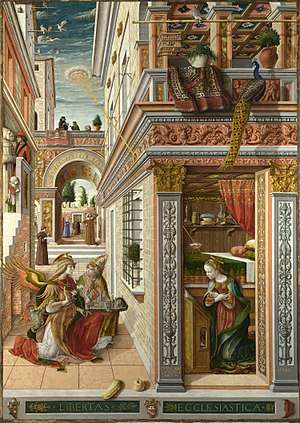The Annunciation, with Saint Emidius
The Annunciation, with Saint Emidius is an altarpiece by Italian artist Carlo Crivelli showing an artistic adaptation of the Annunciation. The altarpiece was painted for the Church of SS. Annunziata in the Italian town of Ascoli Piceno, in the region of Marche, to celebrate the self-government granted to the town in 1482 by Pope Sixtus IV.[1] The painting was removed to the Pinacoteca di Brera in Milan in 1811, but passed to Auguste-Louis de Sivry in 1820, and had reached England by the mid-19th century. It has been housed in the National Gallery in London since it was donated by Henry Labouchere, 1st Baron Taunton in 1864.[1]
| The Annunciation, with Saint Emidius | |
|---|---|
 | |
| Artist | Carlo Crivelli |
| Year | 1486 |
| Type | Egg and oil on canvas |
| Dimensions | 207 cm × 146.7 cm (81 in × 57.8 in) |
| Location | National Gallery, London |
Themes
The light ray from the heaven represents Mary's impregnation by the Holy Spirit.[2] The closed passage into the depth at the left and the flask of pure water in Mary's bedroom conventionally refer to Mary's virginity.[2] The winged angel Gabriel is depicted with Saint Emidius, the patron saint of Ascoli Piceno carrying a model of that town.[1] The apple in the foreground represents the forbidden fruit and associated fall of man. The cucumber symbolizes the promise of resurrection and redemption.[2] The peacock symbolizes associated immortality, because it was believed that its flesh never decayed.[2] An oriental carpet adorns the loggia on the first floor of the Mary's house.
The bottom portion of the painting features the coats of arms of Pope Sixtus IV and the local bishop, Prospero Caffarelli.[1] The Latin words libertas ecclesiastica (church liberty) refer to the self-government of Ascoli Piceno under the general oversight of the Catholic Church.[2] In fringe theories, the halo of the Holy Spirit on the painting is sometimes interpreted as an UFO.[3] According to historian Massimo Polidoro who says what you are actually seeing is "a vortex of angels in the clouds, another frequent representation of God in Medieval and Renaissance sacred works of art". Painters at this time used "symbolic meanings that were anything but random." Polidoro calls the UFO explanation, "reinterpreting with the eyes of twenty-first-century Europeans the product of other cultures".[4]
References
- "The Annunciation, with Saint Emidius". The National Gallery. Retrieved 26 June 2015.
- Charles Harrison (2009). An Introduction to Art. Yale University Press. p. 128. ISBN 0300109156.
- Michael Carter (2013). Alien Scriptures: Extraterrestrials in the Holy Bible. Grave Distractions Publications. p. 44. ISBN 0989029344.
- Polidoro, Massimo (2018). "Does the Vatican Hold a Painting of a UFO?". Skeptical Inquirer. Committee for Skeptical Inquiry. 42 (3): 19.